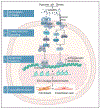New Directions in Therapeutic Angiogenesis and Arteriogenesis in Peripheral Arterial Disease
- PMID: 34110899
- PMCID: PMC8538391
- DOI: 10.1161/CIRCRESAHA.121.318266
New Directions in Therapeutic Angiogenesis and Arteriogenesis in Peripheral Arterial Disease
Abstract
The prevalence of peripheral arterial disease (PAD) in the United States exceeds 10 million people, and PAD is a significant cause of morbidity and mortality across the globe. PAD is typically caused by atherosclerotic obstructions in the large arteries to the leg(s). The most common clinical consequences of PAD include pain on walking (claudication), impaired functional capacity, pain at rest, and loss of tissue integrity in the distal limbs that may lead to lower extremity amputation. Patients with PAD also have higher than expected rates of myocardial infarction, stroke, and cardiovascular death. Despite advances in surgical and endovascular procedures, revascularization procedures may be suboptimal in relieving symptoms, and some patients with PAD cannot be treated because of comorbid conditions. In some cases, relieving obstructive disease in the large conduit arteries does not assure complete limb salvage because of severe microvascular disease. Despite several decades of investigational efforts, medical therapies to improve perfusion to the distal limb are of limited benefit. Whereas recent studies of anticoagulant (eg, rivaroxaban) and intensive lipid lowering (such as PCSK9 [proprotein convertase subtilisin/kexin type 9] inhibitors) have reduced major cardiovascular and limb events in PAD populations, chronic ischemia of the limb remains largely resistant to medical therapy. Experimental approaches to improve limb outcomes have included the administration of angiogenic cytokines (either as recombinant protein or as gene therapy) as well as cell therapy. Although early angiogenesis and cell therapy studies were promising, these studies lacked sufficient control groups and larger randomized clinical trials have yet to achieve significant benefit. This review will focus on what has been learned to advance medical revascularization for PAD and how that information might lead to novel approaches for therapeutic angiogenesis and arteriogenesis for PAD.
Keywords: cytokines; metabolism; microvessels; permeability; stem cells.
Figures


References
-
- Benjamin EJ, Virani SS, Callaway CW, Chamberlain AM, Chang AR, Cheng S, Chiuve SE, Cushman M, Delling FN, Deo R, et al.; American Heart Association Council on Epidemiology and Prevention Statistics Committee and Stroke Statistics Subcommittee. Heart Disease and Stroke Statistics-2018 Update: a Report From the American Heart Association. Circulation. 2018;137:e67–e492. doi: 10.1161/CIR.0000000000000558 - DOI - PubMed
-
- Fowkes FG, Rudan D, Rudan I, Aboyans V, Denenberg JO, McDermott MM, Norman PE, Sampson UKA, Williams LJ, Mensah GE, et al. Comparison of global estimates of prevalence and risk factors for peripheral artery disease in 2000 and 2010: a systematic review and analysis. Lancet. 2013;382:1329–40. doi: 10.1016/S0140-6736(13)61249-0 - DOI - PubMed
Publication types
MeSH terms
Substances
Grants and funding
LinkOut - more resources
Full Text Sources
Medical
Miscellaneous

